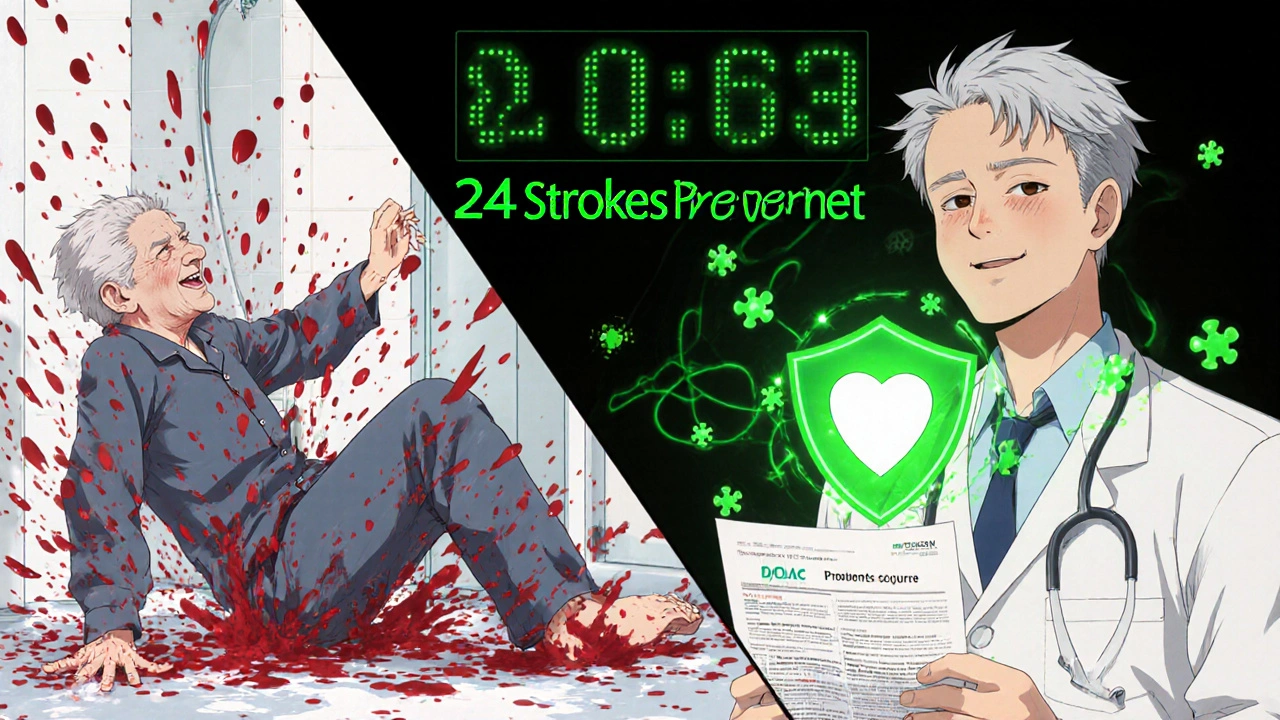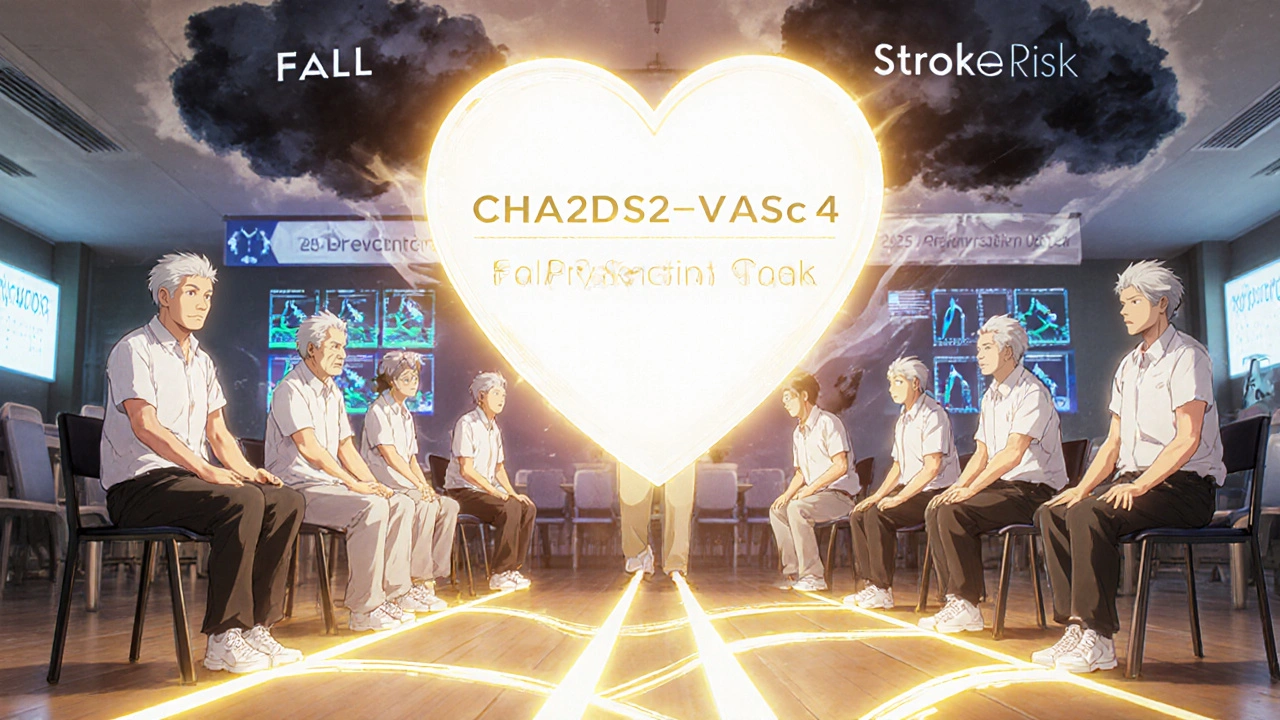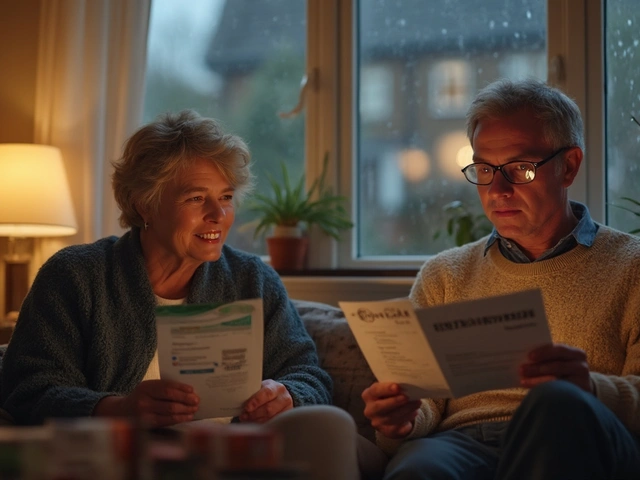When a senior falls, the fear isn’t just about a bruise or a sore hip-it’s about bleeding inside the skull. That’s why many families and even some doctors stop anticoagulants when an older adult has a fall. But here’s the truth: anticoagulants save more lives than they endanger in seniors with atrial fibrillation. The real danger isn’t falling-it’s not treating the irregular heartbeat that could cause a stroke.
Why Anticoagulants Are So Important for Seniors
About 9% of people over 65 have atrial fibrillation, a heart rhythm problem that lets blood pool and clot in the heart. Those clots can travel to the brain and cause a stroke. The risk doesn’t creep up-it explodes with age. At 50-59, your annual stroke risk is 1.5%. By 80-89, it’s 23.5%. That’s more than one in four people. Left untreated, atrial fibrillation turns a normal life into a high-stakes gamble. Anticoagulants cut that risk by two-thirds. Warfarin, used since 1954, reduces stroke risk by about 64%. Newer drugs-called DOACs (dabigatran, rivaroxaban, apixaban, edoxaban)-do just as well, sometimes better. Apixaban, for example, lowered stroke risk by 21% compared to warfarin in people over 75. And here’s the kicker: they cause fewer deadly brain bleeds. Rivaroxaban cuts intracranial hemorrhage risk by 34%. These aren’t small improvements. They’re life-saving.The Fall Fear: Real, But Misplaced
It’s understandable to worry. Seniors fall. About 1 in 3 adults over 65 fall each year. And if they’re on blood thinners, a fall can lead to serious bleeding. Minnesota hospital data shows that 90% of fall-related deaths involve people over 85 or those on anticoagulants. That statistic terrifies families. It makes doctors hesitate. But here’s what the data doesn’t tell you: strokes kill faster and more often than falls. A fall might cause a bleed. A stroke can paralyze, erase memories, or kill within minutes. Studies show that for every 100 octogenarians on anticoagulants for a year, 24 strokes are prevented. Only 3 major bleeds occur. That’s a net gain of 21 lives saved or spared from disability. The American College of Cardiology, American Heart Association, and Heart Rhythm Society all say the same thing: age and fall history should not stop anticoagulation. A 2023 study in the Journal of Hospital Medicine labeled stopping anticoagulants because of falls as “practice for no reason.” That’s how strong the evidence is.DOACs vs. Warfarin: What’s Better for Seniors?
Warfarin works, but it’s a hassle. You need blood tests every few weeks to check your INR. The target range is 2.0-3.0. Most seniors only stay in that range 60-65% of the time. That means unpredictable bleeding risk. DOACs don’t need regular blood tests. They’re fixed-dose: once or twice daily. That’s easier for seniors with memory issues or no transportation to clinics. Apixaban and edoxaban are especially safe for older adults. Apixaban reduces major bleeding by 31% compared to warfarin in patients over 75. But DOACs aren’t perfect. Most are cleared by the kidneys. As people age, kidney function drops. A 90-year-old might have a creatinine clearance of 30 mL/min-too low for standard doses. That’s why doctors now check kidney function every 6-12 months and adjust the dose. For example, apixaban can be lowered from 5 mg to 2.5 mg twice daily if creatinine clearance is under 30 or if the patient is over 80 and weighs under 60 kg. And yes, reversal agents matter. Warfarin can be reversed with vitamin K and fresh plasma. DOACs now have specific antidotes: idarucizumab for dabigatran, andexanet alfa for rivaroxaban and apixaban. These aren’t magic bullets, but they give emergency teams a real tool. In 2021, the AUGUSTUS study showed apixaban had fewer bleeds than warfarin even in patients who had recent bleeding or needed surgery.
What Clinicians Get Wrong
A 2021 survey found that 68% of primary care doctors would withhold anticoagulants from an 85-year-old who’d fallen twice-even if their stroke risk score (CHA₂DS₂-VASc) was 4 or higher. That’s a major problem. A score of 4 means a 7% annual stroke risk. Without treatment, that’s 35% over five years. With treatment, it drops to 2-3%. Doctors aren’t wrong to worry. They’re just misinformed. The fear of bleeding overrides the science. But the data doesn’t lie: the net benefit of anticoagulation increases with age. A 2015 study of 819 patients aged 85-89 and 386 over 90 found the oldest group had the greatest net benefit. The more fragile you are, the more you stand to lose from a stroke. The Beers Criteria, the gold standard for safe prescribing in seniors, still lists anticoagulants as appropriate for atrial fibrillation-even with a history of falls. The only red flag is if the patient has uncontrolled high blood pressure or active bleeding. Falls alone? Not enough.How to Stay Safe While on Anticoagulants
You don’t have to choose between stroke and a fall. You can reduce both risks at once. Start with a fall risk assessment. Use the Morse Fall Scale or a simple home check: Are there loose rugs? Is the bathroom dark? Is there a grab bar? Install nightlights. Remove clutter. Use a cane or walker if needed. Next, review all medications. Many seniors take benzodiazepines for sleep or opioids for pain. These drugs cause dizziness and increase fall risk by 40%. Switching to non-drug sleep aids or switching from opioids to acetaminophen can cut fall risk fast. Exercise is the most powerful tool. The Otago Exercise Program-a set of strength and balance moves done 3 times a week-reduces falls by 35% in seniors. It’s not yoga. It’s chair squats, heel-to-toe walks, leg lifts. Done at home with a physical therapist or even a family member, it works. And don’t skip monitoring. If on warfarin, get INR checked every 4 weeks. If on a DOAC, get kidney function tested every 6-12 months. Ask your doctor: “Is my dose right for my kidneys?”
What’s Changing in 2025
New tools are emerging. AI-powered gait analysis apps can now detect subtle balance problems before a fall happens. Some clinics are using smartphone sensors to track how steadily a patient walks. If their stride slows or wobbles, the system flags them for a fall prevention visit. New dosing guidelines are also out. The 2024 ACC Expert Consensus recommends lower DOAC doses for seniors with mild kidney decline-not just severe. This makes treatment safer without sacrificing protection. And trials like ELDERLY-AF are now studying apixaban in patients over 85. Early results suggest even the very oldest benefit without extra bleeding. This isn’t theory anymore-it’s real-world evidence.The Bottom Line
If you’re a senior with atrial fibrillation, your biggest threat isn’t falling. It’s not taking the right medicine. Anticoagulants are not dangerous because you fall. They’re dangerous if you don’t take them. The data is clear: stroke prevention wins. Every year, 24 strokes are prevented for every 100 octogenarians treated. Three major bleeds happen. That’s a 21-to-3 advantage. That’s not a gamble. That’s a smart choice. Talk to your doctor. Ask: “What’s my stroke risk? What’s my bleeding risk? Is my dose right for my kidneys?” Don’t let fear of falling make you ignore the real threat. Your heart is trying to protect you. Don’t let it be silenced by a myth.Should seniors stop anticoagulants after a fall?
No. A single fall or even multiple falls should not lead to stopping anticoagulants in seniors with atrial fibrillation. Studies show the risk of stroke far outweighs the risk of bleeding from a fall. Guidelines from the American Heart Association and American College of Cardiology state that fall history alone is not a reason to discontinue therapy. Instead, focus on preventing future falls through home safety, balance exercises, and medication review.
Are DOACs safer than warfarin for elderly patients?
Yes, for most seniors. DOACs like apixaban and edoxaban have lower rates of major bleeding-especially dangerous brain bleeds-compared to warfarin. They also don’t require frequent blood tests, making them easier to manage. Apixaban reduces major bleeding by 31% in patients over 75. However, DOACs depend on kidney function, so regular kidney checks are needed. Warfarin may still be used if kidney function is very low or if cost is a barrier.
Can I still take anticoagulants if I have osteoporosis?
Yes. Osteoporosis increases fracture risk if you fall, but it doesn’t make anticoagulants unsafe. The goal is to prevent both falls and strokes. Work with your doctor to strengthen bones with calcium, vitamin D, and weight-bearing exercise. Use fall prevention strategies like grab bars and non-slip mats. Stopping anticoagulants because of osteoporosis increases your stroke risk without eliminating fall risk.
What’s the best way to monitor anticoagulants in seniors?
For warfarin: monthly INR checks to keep levels between 2.0 and 3.0. For DOACs: kidney function tests every 6-12 months using serum creatinine and estimated glomerular filtration rate (eGFR). Dose adjustments are needed if eGFR drops below 50 mL/min. Also, review all medications annually to remove fall-risk drugs like benzodiazepines or opioids. Keep a list of all meds and share it with every provider.
Is it true that anticoagulants are underused in seniors?
Yes, dramatically. Only 55-60% of seniors with atrial fibrillation who should be on anticoagulants are actually taking them. That number drops to 48% for those over 85. The main reason? Fear of bleeding from falls. But studies show that for every 20 seniors treated, one stroke is prevented each year. Underuse leads to preventable strokes, disability, and death.










Wow. So now I’m supposed to believe that letting an 85-year-old take blood thinners is safer than just... letting them be careful? Sure. 🙄
The data is compelling: anticoagulants reduce stroke risk by two-thirds in atrial fibrillation patients over 80, while major bleeding events remain statistically rare. The real issue is not the medication-it’s the systemic failure to implement fall-prevention protocols alongside pharmacological management.
Let me tell you something-my grandma took apixaban for five years after her first fall. She didn’t have a single bleed. But she did walk 10,000 steps a day, did Otago exercises with her grandkids, and had nightlights in every hallway. She didn’t die from a stroke. She died at 94, surrounded by photos of her great-grandkids. That’s what prevention looks like-not fear.
Doctors aren’t evil. They’re tired. And they’re scared of lawsuits. But families? We can be the ones who push back. We can demand kidney checks. We can install grab bars. We can say: ‘No, we’re not stopping the meds. We’re upgrading the home.’
This isn’t about pills. It’s about dignity. It’s about outliving fear.
Here’s the thing nobody says out loud: if your parent is falling, it’s not the anticoagulant that’s the problem-it’s the fact that nobody’s been checking their vision, their meds, or their balance in years. We blame the pill because it’s easier than admitting we stopped paying attention.
My uncle stopped warfarin after a tumble. Six months later, he had a massive stroke. Left side paralyzed. Couldn’t speak. Now he’s in a nursing home. And guess what? The doctor who told him to quit? Still gets paid. My uncle? His life is gone.
Don’t let fear make you the villain in your own family’s tragedy.
so you saying the gov and big pharma just made up all this fall risk stuff to sell more pills lol? i mean if it was so safe why do all the ads say "risk of brain bleed" like 17 times? and why do they always skip the part where the old lady drops her coffee and cracks her skull open? lol
also my cousin’s neighbor took apixaban and ended up in the ER with a hemorrhage after tripping on a rug. they say it was "rare" but i saw the news report. it was on youtube. they showed the blood on the linoleum.
trust me. the system is rigged. and they want you scared so you take the pills. and the pills make them rich.
It’s interesting how this post frames the issue as if the only alternative to anticoagulants is passive acceptance of stroke risk, when in reality, there are a multitude of other strategies-ranging from antihypertensive optimization to cardiac ablation procedures-that could be explored before committing a frail elderly person to lifelong anticoagulation, especially when their quality of life is already compromised by polypharmacy, cognitive decline, and social isolation. The data may support the statistical benefit, but the human cost of a cerebral hemorrhage in a non-ambulatory, demented 92-year-old with no advance directive is rarely quantified in randomized trials.
And while DOACs are easier to manage, they’re also more expensive, less reversible in some settings, and their long-term effects in the very elderly are still being studied. The fact that guidelines recommend them doesn’t mean they’re universally appropriate. Individualization is key. And yet, here we are, with a one-size-fits-all narrative.
There is a metaphysical paradox here: we fear death more than we fear the slow erosion of autonomy. We treat anticoagulants as if they are a moral imperative, yet we refuse to confront the true cost of survival-dependency, institutionalization, loss of speech, of memory, of dignity. A stroke is not merely a medical event-it is the erasure of the self. But so too is a life prolonged by pills, surrounded by alarms, unable to walk to the bathroom without assistance.
Is it better to die quickly, cleanly, on the floor? Or to live slowly, chemically tethered to a heart that no longer sings?
The data says one thing. The soul whispers another.
Oh, please. Another Silicon Valley-approved, over-medicated, corporate-cardiology fantasy. You think your grandma’s gonna do Otago exercises while her Medicare Advantage plan cuts her PT visits? You think a 90-year-old with arthritis and dementia is gonna remember to take a pill twice a day? This isn’t a wellness blog-it’s a death sentence disguised as prevention.
And don’t even get me started on DOACs. They’re not safer-they’re just newer. And newer means more profit. And more profit means more pressure on doctors to push them. Meanwhile, real people are getting brain bleeds because their grandkids forgot to refill the prescription.
Stop romanticizing pills. Start fixing the system.
One critical point missing from most discussions: DOACs are not created equal. Apixaban has the most robust safety data in the very elderly, especially when dose-reduced based on renal function, age, and weight. Edoxaban is similarly favorable. Rivaroxaban carries higher GI bleed risk. Dabigatran requires strict adherence-miss a dose, and protection drops sharply.
Also: many seniors on warfarin are not properly managed. INR targets should be 2.0–2.5 for those over 80, not 2.0–3.0. Tighter control reduces bleeding without sacrificing stroke prevention.
And yes-kitchen rugs are a killer. But so are polypharmacy interactions. A 2024 JAMA study showed that removing just one high-risk medication (like a benzodiazepine) reduced fall risk by 41% in anticoagulated seniors.
This isn’t about choosing between pills and falls. It’s about precision medicine: right drug, right dose, right home, right support.
Let’s cut the fluff. The real reason doctors stop anticoagulants after falls isn’t fear-it’s liability. If the patient bleeds, the family sues. If they have a stroke, the family says, ‘We didn’t know.’ So doctors do the math: easier to stop the pill than to explain why it’s still needed.
And the guidelines? They’re written by academics who’ve never held an 87-year-old’s hand while they cry because they can’t get off the toilet.
Real-world medicine isn’t in the JAMA articles. It’s in the ER at 3 a.m., with a family screaming, ‘You told us this was safe!’
Stop pretending this is about data. It’s about fear. And money. And blame.
My dad’s on apixaban. He fell last year-banged his head, didn’t bleed. He did his balance exercises every morning. We put rails in the bathroom. We switched his sleep med to melatonin. He’s 88. Still drives. Still laughs. Still beats me at chess.
You don’t have to choose between living and dying. You choose between being scared and being smart.
Do the work. It’s worth it.
I’ve spent 18 years in geriatric care, and I’ve seen more strokes in seniors who were taken off anticoagulants after falls than I’ve seen major bleeds from those who stayed on them. One woman, 91, stopped warfarin after a tumble. Three months later, she couldn’t move her right arm, couldn’t speak, couldn’t recognize her own daughter. Her son told me, ‘I just didn’t want her to bleed.’ I told him, ‘You didn’t want her to bleed-you wanted to avoid the guilt.’
But here’s the thing: she didn’t die. She lived for another two years. In a nursing home. With a feeding tube. And a heart that still beat.
What’s the cost of survival? That’s the question nobody asks.
But I’ll tell you this: the data doesn’t lie. The fear? That’s what kills.
As someone who has worked with elderly populations across three continents, I can confirm that the cultural perception of aging significantly influences clinical decision-making. In collectivist societies, such as those in East Asia and parts of the Middle East, family consensus often overrides physician recommendations. In contrast, Western individualism leads to over-reliance on medical autonomy, even when cognitive capacity is diminished.
Moreover, the notion that ‘fall risk’ is a sufficient reason to discontinue anticoagulation is a distinctly Western phenomenon, rooted in litigation aversion rather than evidence. In Japan, where fall rates are comparable but anticoagulation adherence remains high, stroke mortality in atrial fibrillation patients is significantly lower.
The solution is not just pharmacological-it is systemic, cultural, and communal.
My grandma’s on apixaban. She fell. Didn’t bleed. Still walks. Still cooks. Still yells at the TV. Stop overcomplicating it.
And yet, the most profound tragedy isn’t the stroke-or even the bleed.
It’s the silence.
The silence of the daughter who didn’t ask about INR checks.
The silence of the doctor who didn’t mention reversal agents.
The silence of the son who thought ‘better safe than sorry’ meant stopping the pill.
We are not failing because of data.
We are failing because we stopped listening.